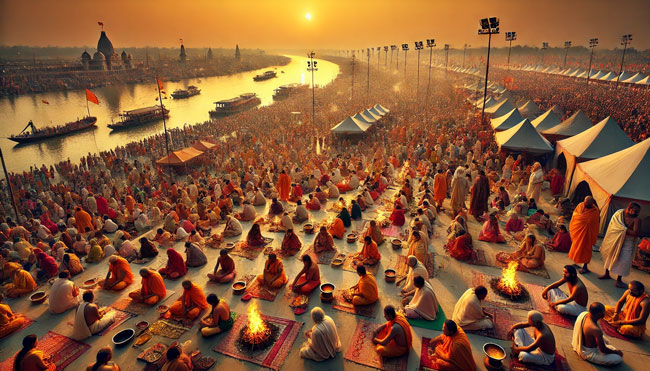 Kalpavas is a unique spiritual observance during the Maha Kumbh, involving fasting, self-restraint, and participation in religious discourses. This year, more than 1 million devotees have undertaken Kalpavas at the sacred confluence in Prayagraj. According to ancient beliefs, residing at the Sangam during the entire Magh month grants the spiritual merit equivalent to a thousand years of penance. Performing Kalpavas during the Maha Kumbh is considered highly auspicious. As per tradition, Kalpavas concludes on Magh Purnima, February 12, when devotees will take a holy dip in the Sangam before completing their spiritual vows through rituals and donations. Afterward, they will leave their temporary shelters and return to their homes.
Kalpavas is a unique spiritual observance during the Maha Kumbh, involving fasting, self-restraint, and participation in religious discourses. This year, more than 1 million devotees have undertaken Kalpavas at the sacred confluence in Prayagraj. According to ancient beliefs, residing at the Sangam during the entire Magh month grants the spiritual merit equivalent to a thousand years of penance. Performing Kalpavas during the Maha Kumbh is considered highly auspicious. As per tradition, Kalpavas concludes on Magh Purnima, February 12, when devotees will take a holy dip in the Sangam before completing their spiritual vows through rituals and donations. Afterward, they will leave their temporary shelters and return to their homes.
Significance of Kalpavas in Maha Kumbh
Kalpavas holds immense spiritual significance in Maha Kumbh, attracting devotees from all corners of the country. According to scriptures, Kalpavas is observed from Paush Purnima to Magh Purnima, a period dedicated to fasting, self-discipline, and spiritual discourses on the banks of the Sangam. Some devotees begin their Kalpavas from Ekadashi in the Paush month and conclude it on Dwadashi in the Magh month. On February 12, Magh Purnima, devotees will perform a holy dip in the Sangam to mark the end of their Kalpavas. As per the Padma Purana, Lord Dattatreya established the rules for Kalpavas, which include bathing in the holy river, performing prescribed rituals, and completing the vows with offerings to their pilgrimage priests.
Rituals After Kalpavas: Worship, Fire Sacrifices, and Charitable Offerings
According to scriptures, after the holy dip on Magh Purnima, Kalpavasis observe a day-long fast and return to their huts to participate in a Satyanarayan Katha (religious discourse) and perform a sacred fire ritual (Havan-Puja). They complete their vow by offering donations to their pilgrimage priests and immersing barley seeds sown at the beginning of Kalpavas into the Ganga. The Tulsi plant they nurtured during the Kalpavas is taken home, as Tulsi is considered a form of Goddess Lakshmi in Sanatan Dharma. It is believed that completing Kalpavas for 12 consecutive years fulfills the sacred cycle of Maha Kumbh. After returning to their villages, devotees host a community feast, marking the official conclusion of their Kalpavas.
The Mythological Significance of Kumbh Mela
According to Hindu mythology, during the churning of the ocean (Samudra Manthan), a divine nectar (Amrit) emerged, leading to a fierce battle between Devas (gods) and Asuras (demons). This battle lasted 12 celestial days, equivalent to 12 human years. To protect the nectar, Lord Vishnu handed the Amrit pot to Garuda (his divine eagle), and during the flight, a few drops fell at four locations—Haridwar, Prayagraj, Ujjain, and Nashik. These sacred drops of nectar made these locations spiritually significant, leading to the tradition of holding Kumbh Mela every 12 years at these four places.
The Maha Kumbh is not just a festival but a spiritual journey of devotion, discipline, and divine blessings, attracting millions of devotees from around the world.




